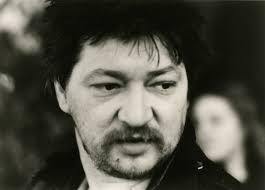by Brooks Riley
‘I can sleep when I’m dead.’
 That’s how Rainer Werner Fassbinder justified his hell-bent, frenetic, productive/destructive dervish whirl through a short existence, trailing an oeuvre of 45 films, 21 plays and countless screenplays. He was 37 when he died.
That’s how Rainer Werner Fassbinder justified his hell-bent, frenetic, productive/destructive dervish whirl through a short existence, trailing an oeuvre of 45 films, 21 plays and countless screenplays. He was 37 when he died.
He’s been sleeping now for 33 years—a well-earned rest he wasn’t quite ready for but did nothing to prevent. He died of an overdose, of life and of every substance that helped fuel his march through it. This year he would have turned 70.
Walking past the Rainer Werner Fassbinder Technical College last week, I found myself doing what I often do with the dead: I imagined his ghost, the Tatar warrior of grunge, clad in filthy Levis and an old leather vest, striding out the door, coming over to me and giving me that bear hug of his.
Was machst Du den hier? he asks, stunned to find me living in his home town of Munich.
What am I doing here? It’s a good question for which I have no easy answer, other than the chain of unrelated circumstances that has brought me here, over and over again, at various times in my life. Now I’ve been here longer than I’ve been anywhere else.
Fassbinder’s Munich is not my Munich. We never had that much in common, except a love of film and a breezy friendship. Now he lies in a pricey part of town, far from the bars he frequented or the studio where he made many of his films. He’s been honored with his very own Platz, the Rainer-Werner-Fassbinder Platz, in a new residential area near the train station. And a technical college, of all things.
We weren’t always friends. The first time I met him, when a colleague and I were the first to interview him on his first trip to New York, he was restless and impatient, fulfilling an obligation with intelligence but without enthusiasm. Fassbinder could be rude and intimidating, with a bad-boy reputation that served him well against intruders, a category that included nearly everyone outside his inner circle of cast and crew, his only friends. He had many admirers out there in the world, myself included, but none could break through that barrier he put up to all those who would befriend him or wish him well. He had no time.
Read more »
